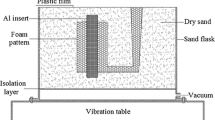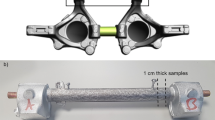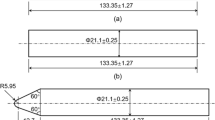Abstract
A practical bimetallic casting consisting of aluminum matrix and cast iron inserts was manufactured via high-pressure die casting (HPDC) process. Different surface treatment methods for the cast iron inserts, including salt membrane plating and electrogalvanizing, were adopted to improve the bonding quality of bimetallic castings. Microstructure characterization on the bonding interface was conducted at different locations of bimetallic castings. Results indicate that compounds with flawless and continuously metallurgical bonding interface can be successfully fabricated by the HPDC process with the zinc rack plating treatment on the surface of cast iron inserts which results in a dense zinc coating with an average thickness of 8 μm. The melt flow speed and heat transition during solidification of the HPDC process are two key factors in determining the bonding integrity of bimetallic castings. With the dissolution and diffusion of the very thin zinc coating during solidification, there is no obvious aggregation of zinc element at the metallurgical bonding interface. Instead, a reaction layer with an irregular tongue-like morphology is formed with an average thickness of approximately 1 μm while it mainly consists of intermetallic phases Al60Cu30Fe10, Fe2Al5, and Al2FeSi.











Similar content being viewed by others
Data availability
The data sets supporting the results of this article are presented within the article itself.
References
Jin K, Yuan QW, Tao J, Domblesky J, Guo XZ (2019) Analysis of the forming characteristics for Cu/Al bimetal tubes produced by the spinning process. Int J Adv Manuf Technol 101(1–4):147–155. https://doi.org/10.1007/s00170-018-2836-6
Shen YY, Jia Q, Zhang X, Liu RH, Wang YM, Cui YY, Yang R (2021) Tensile behavior of SiC fiber-reinforced gamma-TiAl composites prepared by suction casting. Acta Metall Sin (Engl Lett) 34(7):932–942. https://doi.org/10.1007/s40195-020-01170-5
Hu Q, Jiang ZL, Jiang WM, Li GY, Guan F, Jiang HX, Fan ZT (2019) Interface characteristics of Mg/Al bimetal produced by a novel liquid-liquid compound casting process with an Al interlayer. Int J Adv Manuf Technol 101(5–8):1125–1132. https://doi.org/10.1007/s00170-018-2990-x
Liu T, Wang QD, Sui YD, Wang QG, Ding WJ (2016) An investigation into interface formation and mechanical properties of aluminum-copper bimetal by squeeze casting. Mater Des 89:1137–1146. https://doi.org/10.1016/j.matdes.2015.10.072
Liu GP, Wang QD, Liu T, Ye B, Jiang HY, Ding WJ (2017) Effect of T6 heat treatment on microstructure and mechanical property of 6101/A356 bimetal fabricated by squeeze casting. Mater Sci Eng A 696:208–215. https://doi.org/10.1016/j.msea.2017.04.072
Ding ZY, Zhang NF, Yu L, Lu WQ, Li JG, Hu QD (2021) Recent progress in metallurgical bonding mechanisms at the liquid/solid interface of dissimilar metals investigated via in situ X-ray imaging technologies. Acta Metall Sin (Engl Lett) 34(2):145–168. https://doi.org/10.1007/s40195-021-01193-6
Jiang WM, Fan ZT, Li GY, Liu XW, Liu FC (2016) Effects of hot-dip galvanizing and aluminizing on interfacial microstructures and mechanical properties of aluminum/iron bimetallic composites. J Alloy Compd 688:742–751. https://doi.org/10.1016/j.jallcom.2016.07.085
Springer H, Kostka A, Payton EJ, Raabe D, Kaysser-Pyzalla A, Eggeler G (2011) On the formation and growth of intermetallic phases during interdiffusion between low-carbon steel and aluminum alloys. Acta Mater 59(4):1586–1600. https://doi.org/10.1016/j.actamat.2010.11.023
Liu T, Wang QD, Sui YD, Wang QG (2016) Microstructure and mechanical properties of overcast 6101–6101 wrought Al alloy joint by squeeze casting. J Mater Sci Technol 32(4):298–304. https://doi.org/10.1016/j.jmst.2015.11.020
Li GY, Jiang WM, Guan F, Zhu JW, Zhang Z, Fan ZT (2021) Microstructure, mechanical properties and corrosion resistance of A356 aluminum/AZ91D magnesium bimetal prepared by a compound casting combined with a novel Ni-Cu composite interlayer. J Mater Process Technol 288:116874. https://doi.org/10.1016/j.jmatprotec.2020.116874
Xu JZ, Gao XJ, Jiang ZY, Wei DB, Jiao SH (2016) Microstructure and hot deformation behaviour of high-carbon steel/low-carbon steel bimetal prepared by centrifugal composite casting. Int J Adv Manuf Technol 86(1–4):817–827. https://doi.org/10.1007/s00170-015-8232-6
Zhu ZA, Shi RH, Klarner AD, Luo AA, Chen YQ (2020) Predicting and controlling interfacial microstructure of magnesium/aluminum bimetallic structures for improved interfacial bonding. J Magnes Alloy 8(3):578–586. https://doi.org/10.1016/j.jma.2020.03.004
He K, Zhao JH, Li P, He JS, Tang Q (2016) Investigation on microstructures and properties of arc-sprayed-Al/AZ91D bimetallic material by solid-liquid compound casting. Mater Des 112:553–564. https://doi.org/10.1016/j.matdes.2016.09.085
Zhang H, Chen YQ, Luo AA (2014) A novel aluminum surface treatment for improved bonding in magnesium/aluminum bimetallic castings. Scr Mater 86:52–55. https://doi.org/10.1016/j.scriptamat.2014.05.007
Zare GR, Divandari M, Arabi H (2013) Investigation on interface of Al/Cu couples in compound casting. Mater Sci Technol 29(2):190–196. https://doi.org/10.1179/1743284712Y.0000000096
Li GY, Jiang WM, Yang WC, Jiang ZL, Guan F, Jiang HX, Fan ZT (2019) New insights into the characterization and formation of the interface of A356/AZ91D bimetallic composites fabricated by compound casting. Metall Mater Trans A 50(2):1076–1090. https://doi.org/10.1007/s11661-018-5022-4
Babaee MH, Maleki A, Niroumand B (2019) A novel method to improve interfacial bonding of compound squeeze cast Al/Al-Cu macrocomposite bimetals: simulation and experimental studies. Trans Nonferrous Met Soc China 29(6):1184–1199. https://doi.org/10.1016/S1003-6326(16)64261-9
Hajjari E, Divandari M, Razavi SH, Emami SM, Homma T, Kamado S (2011) Dissimilar joining of Al/Mg light metals by compound casting process. J Mater Sci 46(20):6491–6499. https://doi.org/10.1007/s10853-011-5595-4
Schwankl M, Himmler D, Urban M, Koerner C (2018) Optimization of mechanical properties of Al-Al-compound castings by adapted heat treatment. Adv Eng Mater 20(12):1800400. https://doi.org/10.1002/adem.201800400
Schwankl M, Wedler J, Koerner C (2016) Wrought Al-cast Al compound casting based on zincate treatment for aluminum wrought alloy inserts. J Mater Process Technol 238:160–168. https://doi.org/10.1016/j.jmatprotec.2016.07.001
Jiang WM, Fan ZT, Li C (2015) Improved steel/aluminum bonding in bimetallic castings by a compound casting process. J Mater Process Technol 226:25–31. https://doi.org/10.1016/j.jmatprotec.2015.06.032
Koerner C, Schwankl M, Himmler D (2014) Aluminum–aluminum compound castings by electroless deposited zinc layers. J Mater Process Technol 214:1094–1101. https://doi.org/10.1016/j.jmatprotec.2013.12.014
Rubner M, Gunzl M, Koerner C, Singer RF (2011) Aluminium–aluminium compound fabrication by high pressure die casting. Mater Sci Eng A 528(22–23):7024–7029. https://doi.org/10.1016/j.msea.2011.05.076
Papis KJM, Hallstedt B, Loeffler JF, Uggowitzer PJ (2008) Interface formation in aluminium-aluminium compound casting. Acta Mater 56(13):3036–3043. https://doi.org/10.1016/j.actamat.2008.02.042
Feng J, Ye B, Zuo LJ, Wang QD, Wang QG, Jiang HY (2017) Bonding of aluminum alloys in compound casting. Metall Mater Trans A 48(10):4632–4644. https://doi.org/10.1007/s11661-017-4252-1
Ren QS, Zhao CZ, Li ZB, Zhang HX (2015) Microstructure and mechanical properties of Mg/Al bimetallic composite fabricated by compound casting. Mater Res Innov 19:S73–S78. https://doi.org/10.1179/1432891715Z.0000000001520
Jiang ZL, Fan ZT, Jiang WM, Li GY, Wu Y, Guan F (2018) Interfacial microstructures and mechanical properties of Mg/Al bimetal produced by a novel liquid-liquid compound casting process. J Mater Process Technol 261:149–158. https://doi.org/10.1016/j.jmatprotec.2018.06.013
Li XB, Xiong SM, Guo ZP (2016) Characterization of the grain structures in vacuum-assist high-pressure die casting AM60B alloy. Acta Metall Sin (Engl Lett) 29(7):619–628. https://doi.org/10.1007/s40195-016-0430-1
Li XB, Xiong SM, Guo ZP (2016) Correlation between porosity and fracture mechanism in high pressure die casting of AM60B alloy. J Mater Sci Technol 32(1):54–61. https://doi.org/10.1016/j.jmst.2015.10.002
Yu WB, Ma CS, Ma YH, Xiong SM (2021) Correlation of 3D defect-band morphologies and mechanical properties in high pressure die casting magnesium alloy. J Mater Process Technol 288:116853. https://doi.org/10.1016/j.jmatprotec.2020.116853
Su CY, Li DJ, Wang J, Shi RH, Luo AA, Zeng XQ (2020) Enhanced ductility in high-pressure die casting Mg-4Ce-xAl-0.5Mn alloys via modifying second phase. Mater Sci Eng A 773:138870. https://doi.org/10.1016/j.msea.2019.138870
Margetis D (2009) Homogenization of reconstructed crystal surfaces: Fick’s law of diffusion. Phys Rev E 79(5):052601. https://doi.org/10.1103/PhysRevE.79.052601
Ding HP, Bao XQ, Jamili-Shirvan Z, Jin JS, Deng L, Yao KF, Gong P, Wang XY (2021) Enhancing strength-ductility synergy in an ex situ Zr-based metallic glass composite via nanocrystal formation within high-entropy alloy particles. Mater Des 210:110108. https://doi.org/10.1016/j.matdes.2021.110108
Funding
This work was financially supported by the National Natural Science Foundation of China (No. 51805389), Higher Education Discipline Innovation Project (B17034), and the fund of the Hubei Key Laboratory of Advanced Technology for Automotive Components, Wuhan University of Technology (XDQCKF2021011).
Author information
Authors and Affiliations
Corresponding author
Ethics declarations
Ethics approval
Not applicable.
Consent to participate
The authors have informed consent.
Consent for publication
Not applicable.
Conflict of interest
The authors declare no competing interests.
Additional information
Publisher's Note
Springer Nature remains neutral with regard to jurisdictional claims in published maps and institutional affiliations.
Rights and permissions
About this article
Cite this article
Wu, M., Yang, J., Huang, F. et al. Bonding of cast iron-aluminum in bimetallic castings by high-pressure die casting process. Int J Adv Manuf Technol 120, 537–549 (2022). https://doi.org/10.1007/s00170-022-08816-x
Received:
Accepted:
Published:
Issue Date:
DOI: https://doi.org/10.1007/s00170-022-08816-x




